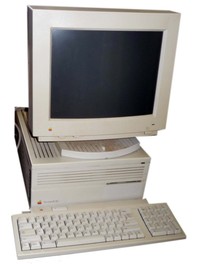|
The Apple Macintosh IIci was an improvement on the Macintosh IIcx. Sharing the same compact case design with three expansion slots, the IIci improved upon the IIcx's 16 MHz Motorola 68030 CPU and 68882 FPU, replacing them with 25 MHz versions of these chips. The IIci came with either a 40 or an 80 megabyte hard disk. A logic board upgrade was available for IIcx owners. The Quadra 700's case uses the same form factor, and a logic board upgrade was made available for both the IIcx and IIci upon the Quadra's introduction in 1990.
The IIci introduced a lot of technical and architectural enhancements, some of which were important in preparing for System 7 (which was then called the Blue project) and would influence future Macs, though some of them came at the cost of compatibility:
A completely new, 32-bit clean ROM with built-in 32-bit QuickDraw that consists of 2 parts: one part that is the same across all Macs, and another area (called the overpatch area) that is specific to each Mac.
Discontiguous physical memory that are mapped into a contiguous memory area by the MMU. Some of the System 7 VM functions had to be added to the ROM to support getting the physical address of the memory.
An optional 32KB Level 2 cache. The cache card, which fitted into a special slot on the motherboard, was later included in all systems at no charge. Third-party cards offered up to 128KB, but the added RAM yielded little benefit over the base card.[1]
A first for a non-all-in-one Mac — onboard graphics for an external display. This freed one of the system's three NuBus slots. However, because the integrated graphics used the system's RAM for its frame buffer, some users used a NuBus graphics card to reclaim the lost memory. Also, it was popular to install faster memory in the first bank of SIMM slots, as this is the bank used by the video subsystem.
The IIci was one of the most popular and longest lived Mac models of all time. For much of its lifespan, it was the business "workhorse" of the Macintosh line. For a short time in 1989, before the introduction of the 40 MHz Macintosh IIfx, the IIci was the fastest Mac available.
Introduction Date: September 20, 1989
Discontinued Date: February 10, 1993
Processor Speed: 25 MHz Processor Type: 68030
Details: This model has a 32-bit processor and a 32-bit data path.
Processor Upgrade: Third-Party* FPU: 68882
System Bus Speed: 25 MHz Cache Bus Speed: N/A
RAM Type: 30-pin SIMM Min. RAM Speed: 80 ns
Standard RAM: 1 MB, 4 MB Maximum RAM: 128 MB
Details: As the Macintosh IIci is "32-bit clean," no additional system extensions are required to use 128 MB of RAM.
Standard VRAM: 64k-320k* Maximum VRAM: 64k-320k*
Display Support: Single Display* Resolution Support: 512x384, 640x480*
Details: The onboard video is capable of supporting a single display -- 512x384 and 640x480 at 8-bit in either landscape or portrait orientation. However, the Macintosh IIci can support as many as four displays with three added NuBus video cards.
Standard Hard Drive: 40 MB, 80 MB* Int. HD Interface: SCSI
Manufacturer: Apple
Date: 20th September 1989
Comment on This Page
Other Systems Related To Apple Macintosh IIci:
This exhibit has a reference ID of CH29897. Please quote this reference ID in any communication with the Centre for Computing History.
|
|
Click on the Image(s) For Detail
|























